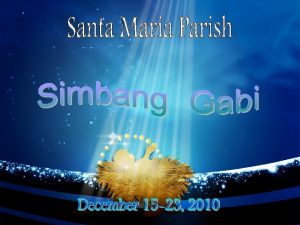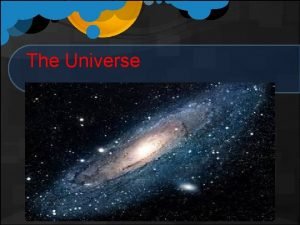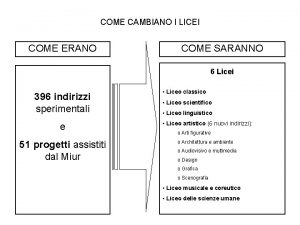The Universe Ersan Demiralp Where Do We Come























- Slides: 23

The Universe Ersan Demiralp

Where Do We Come From? What Are We? Where Are We Going? Paul Gaugin ( 1897 -1898, Tahiti)

Comprehensive Image of Galaxies by using the Hubble Space Telescope Observable Universe : About 1011 Galaxies and about 1011 stars in each galaxy

Primordial singularity is sometimes called "the Big Bang"

Age of the Earth~ 4. 5 Billion Years from a distance of about 6 billion kilometers

Beginning of the life on the Earth ~3. 5 -4 Billion years Homo Sapiens : 100 -300 Thousand years

Star Gazers The Milky Way First Astronomers

Ancient Civilizations ● Mystical/Magical/Religious Ideas about the Universe Gaia=The Earth Goddess

The Ionian Enlightenment The Milesian School (Miletus/Milet, Aydın) Thales, Anaximander, Anaksagoras Natural philosophy They tried to explain natural phenomena within the Nature with no reference to gods.

The Solar System The Kuiper belt

Studies on the Solar System … Aristarchus (heliocentric system) Ptolemy (nested spheres, epicycles) … Copernicus (heliocentric system) Brahe (Observations) Kepler (Kepler Laws) Galileo (Telescope, Moons of Jupiters, extra heavens ? ? ) …

Scientific Revolution (~1500 - ~1700) Scientific method Observations, Experiments, Hypothesis, Theory, Checks; Observations, Experiments, …. Science is a progressive discipline.

Calculus Finally, Calculus was invented by Newton and Leibniz separately Newton used calculus to prove the Keplerian Laws.

The 18 th Century Age Of Reason (Age of Enlightenment) "Dare to Think" Immanuel Kant

Great Mathematicians and Physicists Euler, Lagrange, Laplace, Hamilton… Consistent foundations of Classical Mechanics

● Success of Classical Mechanics Comparing Theoretical Calculations and Observations Perturbations in the orbit of Uranus by an Unknown Planet ↓ Discovery Of Neptune

Problems which can not be solved by Classical Mechanics • Properties of Electromagnetic waves • Precession (change of orbit) of Mercury, … Einstein Special and General Relativity Gravitational fields are described by curved space-time.

Expansion of The Universe (Hubble) All galaxies move away from each other. Farther galaxies move faster The Cosmological Principle: On a sufficiently large scale, the properties of the universe are the same for all observers ( The universe is isotropic and homogeneous). The Copernican Principle : There is no special place in the universe (there is no "center of the Universe"). Current observation (1998): Accelerated expansion of the Universe Explanation: Dark Energy. What is dark energy?

Non-Keplerian results for stars around their galaxy centers→Dark General Relativity : The Einstein Equations + 5% visible matter+ 27 % dark matter + 68 % dark energy (Current values) (Insert these quantities into the Einstein equations) matter? Cosmology: Dynamics of the Universe

Classical Mechanics fails at the atomic level. Classical Mechanics is an approximation Quantum Mechanics Small scale vs. Large scale Understanding of Large Scale (The Universe) ↔ Understanding of Small Scale (elementary particles)

Achievements of Science and unsolved problems go hand by hand. Age of the Earth Dynamics of the planets X-Ray Astronomy, γ-Ray Astronomy , … New Platenary Systems Star evolutions, Neutron stars Supernova, … …? Nature of Dark Matter, Dark Energy, the cause the increase of entropy, quantum gravity, … ?

Science is a progressive discipline. Questions lead to answers, then these answers lead to new questions. Where Do We Come From? What Are We? Where Are We Going? * What’s the initial singularity? Its properties? * What is Life? *What is the fate of the Universe? Forever Expansion? Big Crunch? … … …

THANK YOU !
 Mogan's cevicheria
Mogan's cevicheria Come mi chiamo come mi chiamo
Come mi chiamo come mi chiamo Past form tear
Past form tear Softly and tenderly jesus is calling
Softly and tenderly jesus is calling Come holy ghost lyrics
Come holy ghost lyrics Past participle verbs drink
Past participle verbs drink E m m a n u e l
E m m a n u e l Come mi vedono gli altri e come mi vedo io
Come mi vedono gli altri e come mi vedo io What is the theme of the story hey come on out
What is the theme of the story hey come on out Come in come in and sit down
Come in come in and sit down Come mi chiamo
Come mi chiamo Get in touch with god turn your radio on
Get in touch with god turn your radio on Come thou fount come thou king
Come thou fount come thou king Come in come in and sit down
Come in come in and sit down Through all generations everlasting is his mercy
Through all generations everlasting is his mercy Phối cảnh
Phối cảnh Một số thể thơ truyền thống
Một số thể thơ truyền thống Thế nào là hệ số cao nhất
Thế nào là hệ số cao nhất Ng-html
Ng-html Sơ đồ cơ thể người
Sơ đồ cơ thể người Bảng số nguyên tố
Bảng số nguyên tố Tư thế ngồi viết
Tư thế ngồi viết đặc điểm cơ thể của người tối cổ
đặc điểm cơ thể của người tối cổ Mật thư tọa độ 5x5
Mật thư tọa độ 5x5










































